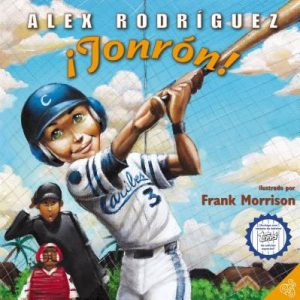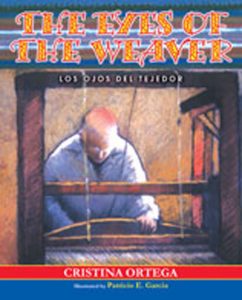 Cristina Ortega is the granddaughter of Juan Melquiades Ortega, a master weaver of northern New Mexico’s Chimayó Valley. Chimayó’s roots are in early Spanish Colonial times and has long been famous for its unique weavings. Juan M. Ortega was taught to weave by his father in the early days when weavers sheared their own sheep and spun and dyed the wool for their blankets. El Tejedor (The Weaver) continued weaving until he was one hundred years old, when his eyesight failed him. In The Eyes of the Weaver, Cristina shares her memories of visits when she was ten years old with Grandpa in the village of Chimayó, where he taught her how to weave. She also recalls how Grandma helped her husband choose color combinations for his Chimayó blankets. It was during these visits that Cristina learned how important it is for a child to listen to and learn from his or her relatives.Some of Juan M. Ortega’s weavings and tools of the trade have been included in the exhibit, “American Encounters,” at the National Museum of American History, Smithsonian Institution, in Washington, D.C.Reading level: 10 years and up
Cristina Ortega is the granddaughter of Juan Melquiades Ortega, a master weaver of northern New Mexico’s Chimayó Valley. Chimayó’s roots are in early Spanish Colonial times and has long been famous for its unique weavings. Juan M. Ortega was taught to weave by his father in the early days when weavers sheared their own sheep and spun and dyed the wool for their blankets. El Tejedor (The Weaver) continued weaving until he was one hundred years old, when his eyesight failed him. In The Eyes of the Weaver, Cristina shares her memories of visits when she was ten years old with Grandpa in the village of Chimayó, where he taught her how to weave. She also recalls how Grandma helped her husband choose color combinations for his Chimayó blankets. It was during these visits that Cristina learned how important it is for a child to listen to and learn from his or her relatives.Some of Juan M. Ortega’s weavings and tools of the trade have been included in the exhibit, “American Encounters,” at the National Museum of American History, Smithsonian Institution, in Washington, D.C.Reading level: 10 years and up
Author: Book Importer
Fiesta Fiasco
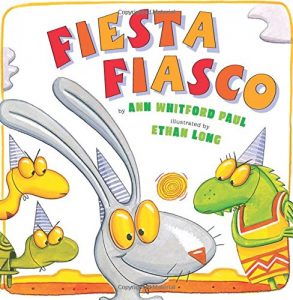 There is another desert party in the works in this spicy companion book to Mañana, Iguana. This time it is Snake’s birthday, and Iguana, Tortoise, and Rabbit are shopping for birthday gifts to bring to his fiesta. But what presents should they buy for Snake? In a sneaky twist, Rabbit convinces them to buy gifts that aren’t for Snake at all—but for him! With a clever text, a spattering of Spanish vocabulary. and lively illustrations, this author-illustrator team presents quite the fiesta fiasco. Glossary included.
There is another desert party in the works in this spicy companion book to Mañana, Iguana. This time it is Snake’s birthday, and Iguana, Tortoise, and Rabbit are shopping for birthday gifts to bring to his fiesta. But what presents should they buy for Snake? In a sneaky twist, Rabbit convinces them to buy gifts that aren’t for Snake at all—but for him! With a clever text, a spattering of Spanish vocabulary. and lively illustrations, this author-illustrator team presents quite the fiesta fiasco. Glossary included.
Count on Culebra: Go from 1 to 10 in Spanish
 A companion to the popular Manana, Iguana that teaches how to count in spanish. When Iguana stubs her toe, Doctor Culebra comes to the rescue. But his suggestions sound a little loco to everyone else. How will tying un rolling pin and dos kettles to Iguana’s tail make her better? And more importantly, will Iguana feel well enough to make her cactus butter dulces? The extremely popular “Manana, Iguana” has sold and reprinted quickly, and Ann Whitford Paul and Ethan Long’s previous titles have received much praise.
A companion to the popular Manana, Iguana that teaches how to count in spanish. When Iguana stubs her toe, Doctor Culebra comes to the rescue. But his suggestions sound a little loco to everyone else. How will tying un rolling pin and dos kettles to Iguana’s tail make her better? And more importantly, will Iguana feel well enough to make her cactus butter dulces? The extremely popular “Manana, Iguana” has sold and reprinted quickly, and Ann Whitford Paul and Ethan Long’s previous titles have received much praise.
First Day in Grapes
All year long, Chico’s family moves up and down the state of California to pick fruits and vegetables. Every September, Chico starts at a new school. Often, the other kids pick on him — maybe because he’s always new, or maybe because he speaks Spanish sometimes. But third grade promises to be different. He likes his teacher, and she recognizes his excellent abilities in math — he may even get to go to the math fair! When some fourth-grade bullies tease him, he surprises them with strengths of his own.
This book has been included in WOW’s Kids Taking Action Booklist. For our current list, visit our Boolist page under Resources in the green navigation bar.
Angel City
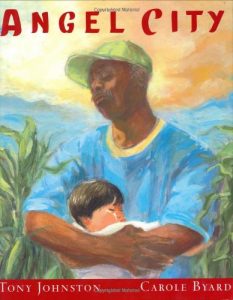 Old man Joseph never imagined a family could start this way. When he finds a baby abandoned on a lonely L.A. street, he vows to raise it as his own. He’s an old farmer and knows nothing of parenting, even less about raising a Mexican baby.Yet Joseph keeps his promise and with time he realizes that even in the darkest barrio, there is a world to explore, songs and stories to be shared. Even in the darkest barrio, there is love.
Old man Joseph never imagined a family could start this way. When he finds a baby abandoned on a lonely L.A. street, he vows to raise it as his own. He’s an old farmer and knows nothing of parenting, even less about raising a Mexican baby.Yet Joseph keeps his promise and with time he realizes that even in the darkest barrio, there is a world to explore, songs and stories to be shared. Even in the darkest barrio, there is love.
Illustrated by Caldecott-Honor Medal winner Carol Byard and beautifully told by Tony Johnston, Angel City is a moving tribute to the strength of family no matter its form.
Play Ball!
Sí, Puedes (Play Ball!)
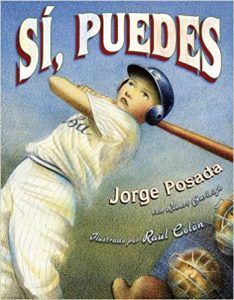 Presents a story of right-handed Jorge Posada being coached by his father to bat left-handed, and how it leads right to the major leagues.
Presents a story of right-handed Jorge Posada being coached by his father to bat left-handed, and how it leads right to the major leagues.
Jorge Posada adora sentir la bola en su guante, el bate en su mano, y el juego del béisbol. Como cualquier otro jugador del equipo Casa Cuba, ya puede batear bien con la mano derecha, pero su padre le dice, “Ser bueno no es ser el mejor.”Su entrenador le dice, “El béisbol es un juego de pulgadas.” De hecho, cuando Casa Cuba tiene que enfrentarse al temible pítcher de Club Caparra, lo que el equipo más necesita es un jugador ambidiestro.Basado en la infancia de Jorge Posada, el cátcher de los New York Yankees, ésta es la historia de un niño puertorriqueño que trabajó duro para convertirse en el mejor, y no se detuvo sino hasta que llegó a ser campeón.
I’m Just Like My Mom; I’m Just Like My Dad/ Me parezco tanto a mi mama; Me parez
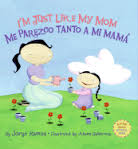
I’m just like my mom.
Me parezco tanto a mi mamá.
I’m just like my dad.
Me parezco tanto a mi papá.
With Akemi Gutiérrez’s charming illustrations, renowned journalist Jorge Ramos explores the many ways in which all children are just like their parents—in two languages!
Junto con las simpáticas ilustraciones de Akemi Gutiérrez, el respetado periodista Jorge Ramos explora las varias maneras en que los hijos se parecen a sus padres. ¡Y lo hace en dos idiomas!
Jonron!
El Regalo Del Lenador / The Woodcutter’s Gift
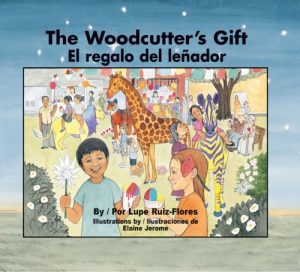 One day, a terrible thunderstorm knocked down the giant mesquite tree that grew in the town square. After the storm, the townspeople gathered to gawk at the large obstruction blocking the street. They weren’t sure what to do with it, but they all agreed that the wood was good for nothing except a fire. But the woodcutter Tomás sees something in the huge tree that the rest of the townsfolk don’t. “The beauty of this tree is not on the outside but on the inside,” Tomás tells them. In the following days, everyone watches curiously as the woodcutter carves and chips and whittles the wood into blocks. At one point, he moves the chunks into his shed, increasing everyone’s curiosity. What could the woodcutter be doing with all that lumber? Finally, Tomás calls the townsfolk together to see his creations: a wonderful collection of life-sized animals for the children to enjoy. Children and adults alike are thrilled with their private zoo! But a few weeks later the woodcutter is visited by strangers from a folk-art museum who want to buy the pieces for their collection. Will Tomás sell the town’s new zoo animals so that others can enjoy them too?
One day, a terrible thunderstorm knocked down the giant mesquite tree that grew in the town square. After the storm, the townspeople gathered to gawk at the large obstruction blocking the street. They weren’t sure what to do with it, but they all agreed that the wood was good for nothing except a fire. But the woodcutter Tomás sees something in the huge tree that the rest of the townsfolk don’t. “The beauty of this tree is not on the outside but on the inside,” Tomás tells them. In the following days, everyone watches curiously as the woodcutter carves and chips and whittles the wood into blocks. At one point, he moves the chunks into his shed, increasing everyone’s curiosity. What could the woodcutter be doing with all that lumber? Finally, Tomás calls the townsfolk together to see his creations: a wonderful collection of life-sized animals for the children to enjoy. Children and adults alike are thrilled with their private zoo! But a few weeks later the woodcutter is visited by strangers from a folk-art museum who want to buy the pieces for their collection. Will Tomás sell the town’s new zoo animals so that others can enjoy them too?
Illus: woodcuts


